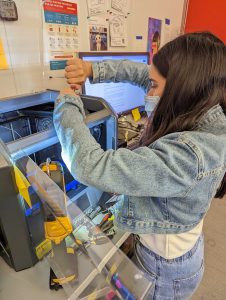As a first-year student worker at the Makerspace in Williams College, I have encountered my time here to be highly enriching. In these two months, I have learned core abilities that have helped develop my problem-solving and analytical skills as a woman in the STEM field. Prior to coming to Williams, I had taken part in two projects related to 3D printing technology in Paraguay (my home country), where I assisted with a 3D store and assembled 3D printed prosthetics, thus I was delighted to have the opportunity to contribute to the Williams College Makerspace.
During the course of my first weeks, I familiarized myself even more with the use of 3D printers, practicing how to properly slice models for printing and changing filaments. I also learned how different modifications in parameters of 3D printers’ slicing software, such as layer height, print speed, supports, infill patterns and temperature are crucial for a 3D print to go smoothly.
Nonetheless, after several successful prints for students’ requests, I have also encountered some obstacles such as clogging and bed adhesion issues. When printing a Minecraft lamp, I found that it had been detached from the printer’s bed, resulting in a waste of filament. To solve this, I used glue or tape — depending on the printer bed material, to help the filament stick better to the platform. In another instance, one of the printers got its filament stuck and clogged the extruder completely, making it unable to properly function. Therefore, I had to unclog it manually, disassembling the extruder to reach the clogged section near the nozzle and cleaning the obstructing filament piece away from the extruder channel tube. A valuable lesson I learned from these experiences is that it is essential to always be alert while the 3D printer is working, and look for strategies to solve the problems that may occur.
As for 3D modeling, I have started experimenting with Fusion360, a specialized software to create and edit pre-existing 3D models. This has been extremely useful to repair corrupted open-source models to efficiently print them. I have used this tool to edit designs students would request. For instance, a student once requested a keyholder that had an open section in the center but wanted the object to have a solid surface without the hole. Thus, I filled the gap using the tools of this specialized software.
Aside from that, I started to become familiar with operating Virtual Reality (VR) equipment, which is an essential and cutting-edge technology that not only allows for fun recreational time but also has academic applications. From playing VR games, like the popular Beat Blaster, to exploring a variety of countries using Google Earth; there is a world of possibilities when it comes to Virtual Reality.
Lastly, I am working on the promotion of the makerspace with peers and faculty to make more members of our campus aware of the wonderful opportunities at the Makerspace. Looking forward, I aim to continue increasing my knowledge on these topics to be able to make an impactful contribution to our community at Williams College.

